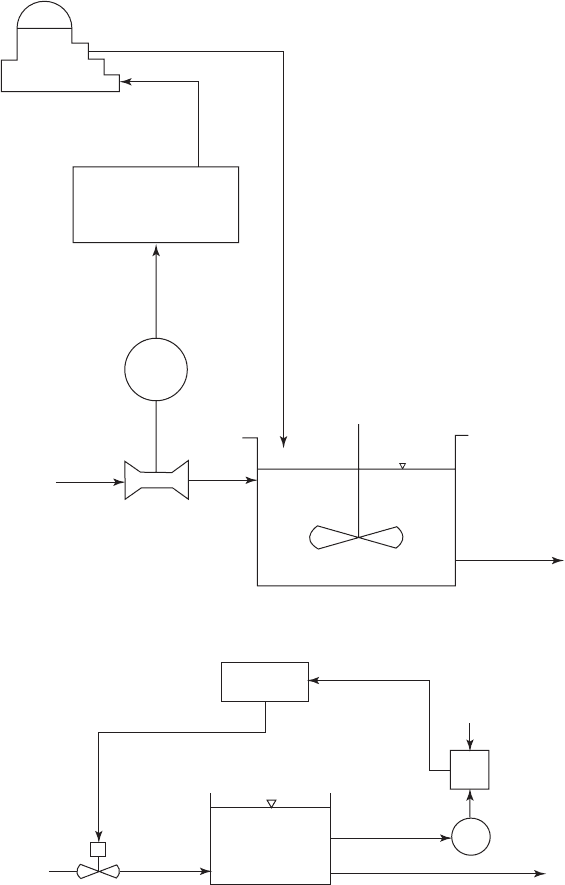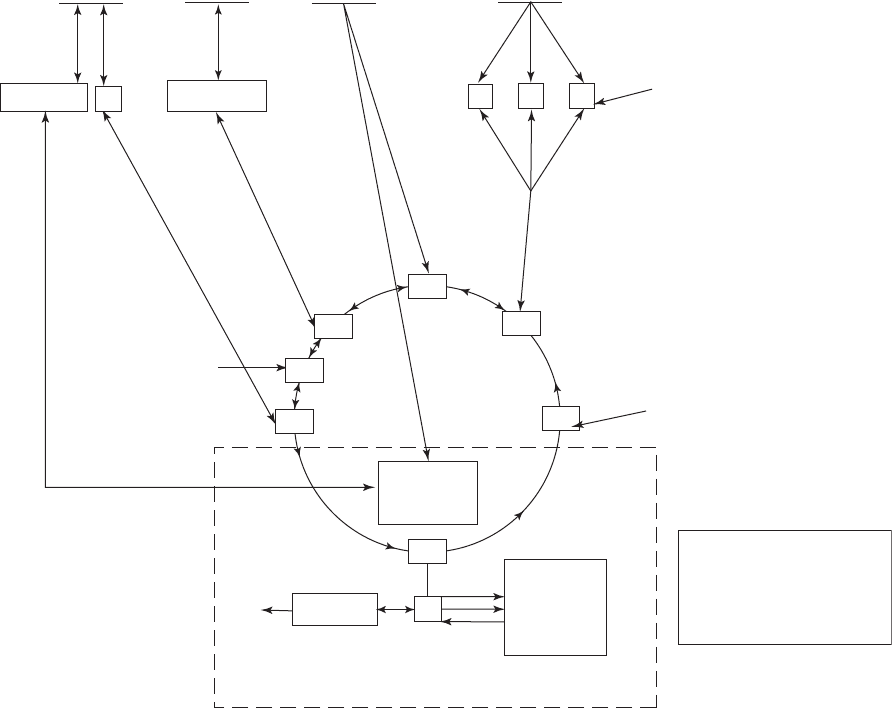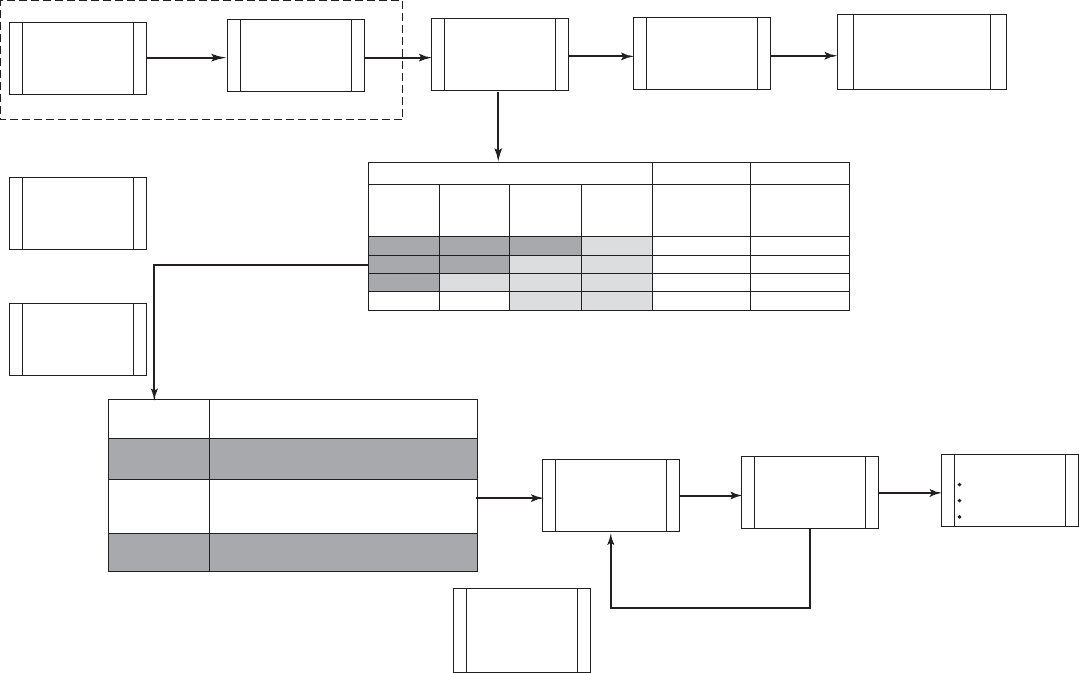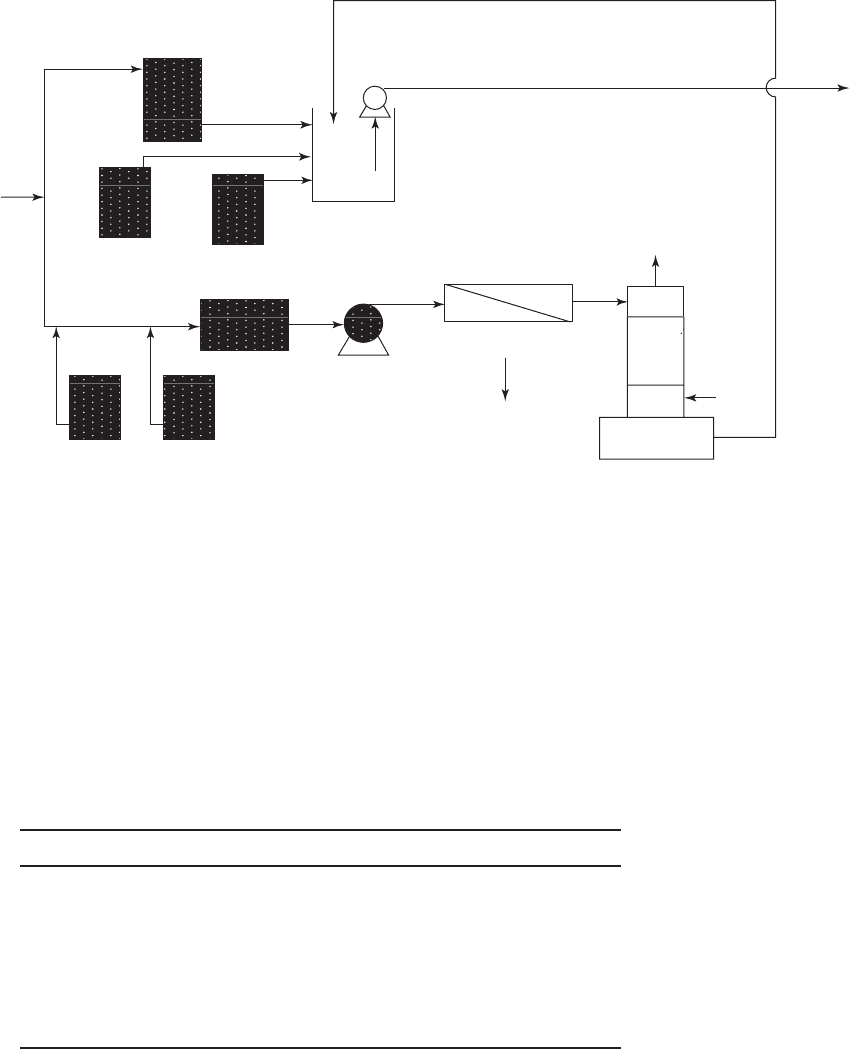Water and Wastewater Engineering
Подождите немного. Документ загружается.


16-28 WATER AND WASTEWATER ENGINEERING
Metering
pump
PLC
(flow proportional)
Influent
Effluent
FIT
FIGURE 16-12
Feed-forward control example: polymer dosing.
FIGURE 16-13
Feed-back control example: tank level control. FIT flow indicating transducer; LIT
level indicating transducer.
PLC
E (t) = error
Set point
(sp)
LIT
Effluent
M
Influent
• Filtration. The number of filters required online is determined by the plant flow and the
optimum flow per filter. In a cascade level flow control, a level signal from the influent
channel is transmitted to a PI level controller. The controller output adjusts the flow set
points for the individual filter flow controllers.
A schematic diagram of the principal fu
nctions of a monitoring and control system are shown in
Figure 16-14 .

DRINKING WATER PLANT PROCESS SELECTION AND INTEGRATION 16-29
FIGURE 16-14
S chematic diagram of principal functions of a monitoring and control system.
Disk
storage
Data
storage
CPU
Alarms
Status
Control
Video terminal
and printer
data tabulation,
analysis, trends,
and graphics
MTU
RTU
RTU
RTU
RTU
RTU
RTU
(Additional RTUs for other
plant process)
Status & limited
control
Con
trol
PCPC
PC
Stat
u
s
Stat
u
s
Control
Control
Control
Conventional
control
Conventional
control
Backup
control
Control
(Local control, not affected by
MTU or CPU malfunction
one PC for each filter)
Filter
backwash
(automatic process)
Tank levels,
water quality
(monitoring)
Chemical feed
pumps
(automatic process)
Influent value
(automatic process)
(Future RTUs
for plant expansion
and d
istribution
system)
Status
Stat
us
& li
m
ited
c
ontrol
Stat
u
s
& li
m
ited
con
trol
Main control
board
(strip charts,
gages, etc.)
Operations building
PC—Programmable controller
RTU—Remote terminal unit
MTU—Main terminal unit
CPU—Central processing unit
Key
PC
Control System Hardware. Of the many pieces of hardware involved in a SCADA system,
three have been selected for discussion here because of their widespread application.
• PLCs. Programmable logic controllers are industrial-grade special-purpose microcomput-
ers with input/output (I/O) subsystems for monitoring an
d controlling process equipment.
• RTUs. Remote terminal units were originally designed to be installed at remote sites and
linked to a central station by low-speed telephone or radio. They originally were designed
to gather status data and had limited or no control capability. As of 2005, RTUs have be-
come m
ore sophisticated. They have better communications capability than PLCs, such as
multiple communications port access from multiple other sites. The differences between
RTUs and PLCs has diminished over the past few years and will continue to do so.
16-30 WATER AND WASTEWATER ENGINEERING
• Field bus. This technology provides digital communication technology to field devices. The
use of this technology has been driven by the desire to reduce cabling cost. The data speed
ranges from 1.2 kb/s to 31.25 kb/s and maximum distances range fro
m 100 m to 1,900 m.
System Design Considerations. The process flow diagram prepared by the project engineer is
the basis for the instrumentation and controls engineer to begin the design. In the design process,
the following documents are usually produced in the sequence listed below (Kawamura, 2000):
1 . Process and instrumentation d
iagram (P&ID).
2. Process control diagram (PCD).
3. Instrumentation input-output summaries (IIOSs).
4. Instrumentation specification sheets (ISSs).
5. Logic diagrams.
6. Panel layout drawings.
7. Loop interconnection drawings (LIDs).
8. Instrumentation installation
details (IIDs).
Because of the rapidity with which computer technology changes, designs that are made two
or three years before the project is built may be obsolete before they are installed. For that matter,
just a few years after the project is built, the technology will have advanced and obsolescen
ce
will begin to set in. There is no particular strategy that is completely acceptable in solving this di-
lemma. In so far as possible, open-ended systems capable of expansion should be specified. The
owner/operator must be realistic in expectations and be prepared for upgrades and renovation as
part of the operation and maintenanc
e budget.
Uninterruptible power supplies (UPSs) are essential because failure of the commercial power
supply during critical operations will have catastrophic results on plant performance. The UPS
capability should be such that it can last until the plant generator backup comes online. Con-
versely, the UPS should have a bypass
switch to allow commercial power to feed directly to the
load if the UPS electronics fail.
The control system is a weak link in the plant’s security unless specific measures are taken to
protect it. These are discussed in the next section.
Hints from the Field. The following hints are offered by those who have to live with SCADA
systems:
• E x
isting facilities should, over several years, phase in SCADA in conjunction with capital
improvement projects such as new pumps and feeders.
• Design redundancy into various aspect of the system in addition to the most critical plant
and remote station processes. PLC/RTU
units that archive files in flash memory ensure
maximum data integrity in the event of a SCADA communication network failure.
• Establish a field instrument database for every field instrument and keep it maintained.
• Design a system that is not proprietary.
DRINKING WATER PLANT PROCESS SELECTION AND INTEGRATION 16-31
• Purchase PLC and computer control systems that can be expanded. Although current proj-
ects do not forecast appreciable growth in demand, increasing regulatory requirements,
business requirements for better asset management, and data for capital improvement pro-
grams will beco
me routine if they are not already routine.
• The life cycle of SCADA systems is about 7 to 10 years. Five years into the life of the sys-
tem an assessment of the behavior of the SCADA system is warranted to address downtime
frequency and duration, data holes, and failures that result from upgrades.
16-4 SECURITY
Introduction
Nothing can be m ade 100 percent secure, but security enhancement and risk reduction are pos-
sible. The challenge for the water utility and the design engineer is to provide an appropriate level
of security by accounting for risk while balancing vulnerability, available capital, operating re-
sources, and operation and maintenance issues. While this chapter focu
ses on the water treatment
plant design, security issues for the utility are much broader and the tec hniques for addressing
security go far beyond the fixed facilities provided in a design.
Like the discussion of SCADA, this discussion is an overview. Some of the pertinent issues
will be highlighted, but many
details will be left for other texts such as Water Supply Systems
Security (Mays, 2004a). In a very broad sense, water supply security encompasses three areas:
critical infrastructure; preparedness, response, and recovery; and communication and informa-
tion. This discussion will, for the most part, be li
mited to critical infrastructure.
The Threats
The probability of a terrorist threat to drinking water is very low; however, the consequence
could be extremely severe for exposed populations (Mays, 2004b). The threats to a water supply
are summarized as:
• Cyber threats. These threats include disruption of the SCADA system.
• Physical threats. Destruction of elevated storage tanks
, water mains, pumping stations, and
chlorine storage facilities that either reduces water pressure and compromises fire fighting
capabilities or releases toxic chlorine gas.
• Chemical threats. The injection of a wide variety of toxic compounds (either chemical war-
fare agents or industrial chemical
s) that result in death or poisoning of large numbers of the
population.
• Biological threats. N umerous pathogens common in developing countries but unseen in the
United States for decades could, in very small doses, start an epidemic in an unprotected
population.
Vulnerability Assessment
Title IV of PL 107-188 (Public Health, Security, and Bioterrorism Preparedness and Response
Act, “Bioterorism Act of 2002”) required community water systems serving populations greater
16-32 WATER AND WASTEWATER ENGINEERING
than 3,300 to conduct vulnerability assessments and submit them to the U.S. EPA by 2004.
Assuming that these communities all did so, the assessments are available for review for renova-
tion and expansion projects. Review of these assessments should be part of the planning process
for new projects. For those projects where vulnerabilit
y assessments do not exist, the need for the
plan should be discussed with the client as part of the planning process.
A number of assessment tools have been developed to assist communities in making the as-
sessment. The U.S. EPA and the National Rural Water Association developed a self-assessment
guide titled Security Self-Assessment Gui
de for Small Systems Serving Between 3300 and 10,000.
These checklists and others are included in Mays (2004c). Commercial software tools such as
Risk Assessment Methodology for Water Utilities (RAM-W
SM
), Vulnerability Self-Assessment
Tool (VSAT), and ASSET are also available.
The assessment tools address the following areas of vulnerability:
1 . Raw water source (surface or groundwater).
2. Raw water channels and pipelines.
3. Raw water reservoirs.
4. Treatment facilities.
5. Connections to distribution systems.
6. Pump s
tations and valves.
7. Finished water tanks and reservoirs.
Figure 16-15 illustrates a qualitative method for assessing asset-based vulnerability. In addi-
tion, especially for distribution systems, modeling is a proven method for assessing the systems
respon
se to an intrusion.
Layered Security
The strategy for providing security for the water treatment plant is called layered security based
on the concept of “security in depth.” A typical water treatment plant may include four or five
security access control levels (Booth et al., 2004):
Level 1 : Public zone.
The area outside of the perimeter fence. It is accessible to the public
.
Level 2 : Clear zone.
The area between the fence and the locked building exterior.
Level 3 : Building lobby.
The area within the building, prior to access the circulation areas in the building.
Level 4 : Interior circulation area.
All the interior areas in the building that are readily accessible.
Level 5 : High value area.

16-33
Asset
categorization
and
identification
Checklist
Identify threats for
each asset
Determine
criticality
Identify
countermeasures
alredy in place
Assign vulnerablity rating
A. Very high
B. High
C. Moderate
D. Low
Determine risk
level
Determine
acceptability
of risk
Identify
improvements for
high-risk assets
Perform
cost-benefit
analysis
Continuity plan
Readiness
Response
Recovery
Iteration
necessary to
identify
improvement
efficacy
Asset risk
level
1A, 1B, 1C
2A, 2B, 2C
Interpretation
These risks must be made a high priority
to be controled or eliminated
These risks may be accepted upon
managements review
1D, 2C, 2D
3B, 3C
3D, 4A, 4B
4C, 4D
These risks may be unacceptable;
however, management may choose to
formally accept these ri
sks
Criticality rating
1
Ve ry high
2
High
3
Moderate
4
Low
Vulnerabilty
level
Loss
event
probability
AVery high
High
Moderate
Low
B
C
D
4A
4B
4C
4D
3A
3B
3C
3D
2A
2B
2C
2D
1A
1B
1C
1D
FIGURE 16-15
A sset-based vulnerability analysis and response planning approach.
16-34 WATER AND WASTEWATER ENGINEERING
Interior areas that are restricted to those that need access. Examples include chemical stor-
age and SCADA rooms.
A ccess control systems are based on something the individual possesses, something the indi-
vidual knows, a physical attribute, or a combination of the three. Possession
can be the simple act
of having a key or identification card. Knowledge implies restricted information such as personal
identification numbers (PIN) or passwords. Physical attributes include such biometrics as finger-
print scanning and iris mapping.
Physical Security. Fencing and controlled
access gates at the boundary of the plant property
provide the first layer of security. Although these can be easily breached, they do two things:
(1) they inhibit random vandalism and (2) they make potential intruders aware that the facility is
being protected and that other less obvious security meas ures are in pla
ce.
Locked doors and the absence of windows at ground level provide another layer of security.
Key locks, key pads, and electrified locks that must be actuated internally each have their advan-
tages and disadvantages.
Warning Systems. Another layer of security is provide
d by systems that alert pers onnel that
individuals are seeking access. These include closed circuit television (CCTV) and access control
systems (ACS). These may be coupled with speaker phone systems to make queries or motion
detectors to alert the staff where access has been
made.
Action Implementation. The effectiveness of the response to an intrusion is time dependent.
Fully automated systems will lock down and alert appropriate authorities . Typical sys tems will
require individuals to respond appropriately.
SCADA Security. Panguluri, Phillips, and Clark (2004) provide lists of observed SCADA vul-
nerabilities and steps to improve SCADA security. In general SCADA security guidance identi-
fies the following design factors:
• SCADA control components should be in locked, access-controlled sites.
• Remote access for maintenance personnel and vendors should be tightly
controlled.
• Multiple layers of access controls (filters, firewalls, etc.) should be built between business
computing networks and the SCADA system.
• Network architecture should be reviewed by a certified security professional prior to design
completion.
• Access to the SCADA operating syste
m should be limited.
• System backups and restoration should be specified to recover from disasters.
• Connection between the SCADA system and the Internet should be limited or prohibited.
Table 16-10 is an example of layered access control.

DRINKING WATER PLANT PROCESS SELECTION AND INTEGRATION 16-35
16-5 CHAPTER REVIEW
When you have completed studying this chapter, you should be able to do the following without
the aid of your textbook or notes:
1 . Explain the concepts of a treatment train and multiple barrier in designing a water
treatment plant.
2. Given a precept of process selection, provide an example to explain it to a client.
3 . Given a process flow sheet and source water characteristics, identify the water quality
characteristi
cs or upstream processes that point to the selection of each of the processes.
4. Define the terms DCS and SCADA and explain how they relate to the engineering and
business decisions for water treatment system design.
5. Explain the difference between local control and computer control of processes.
6 . E
xplain the difference between feed-forward, feed-back, and proportional control systems.
Security access
zone Affected areas
Access control
process
Other complementary
security measures
Level 1 Public areas outside
perimeter fence
N/A—Public Zone No trespassing signage, guard house with
security officer checking vehicles
Level 2 Clear zone N/A High visibilit
y site lighting
Perimeter CCTV surveillance
Level 3 Building lobby area Visual inspection by security
officer (or staff member)
CCTV surveillance of incoming personnel
(body size and facial features)
Badge display
Inspection of parcels, packages Hardened blast-resis
tant exterior doors, with
electronic mortise locks
Interlocked exterior and interior lobby doors
Door switch devices
Level 4 Interior circulation
corridor
Card access Interior motion detection
General mechanical
spaces
Level 5 Chlorine storage areas Card access PIN CCTV surveillance of high value areas
SCADA work
station areas
Laboratory areas
Security equipment room
A dapted from Booth et al., 2004.
TABLE 16-10
Water system—layered access control (example)
Visit the text website at www.mhprofessional.com/wwe for supplementary materials
and a gallery of photos.
16-36 WATER AND WASTEWATER ENGINEERING
7. Given a simple process description such as pump control or reservoir volume, select an
appropriate algorithm for controlling it from the following four choices: feed-forward,
feed-back, proportional, and compound control.
8. Define the terms PLC and RTU.
9. List the three broad areas included in providing water system
security.
10. Explain the need for a vulnerability assessment and describe a simple qualitative
assessment strategy.
11. Explain the concept of layered security and give some examples.
W ith the aid of this text, you should be able to do the following:
12. Given a process flow sheet and source water
characteristics, identify alternative
processes that may have or should have been considered.
13. Given a source water quality characteristics and design criteria, perform a screening
analysis to select an initial set of processes for further evaluation.
14. Given a selecte
d list of processes, organize them into a treatment train and draw and
label a process flow diagram.
15. Design an orifice weir for a launder.
16. Design the launder cross section.
17. Sketch and label the hydraulic gradient given the elevations and headlosses for each of
the processes.
16-6 PROBLEMS
16-1. In Case Study 16-2, DAF was selected as part of the residuals treatment process.
Explain what water quality characteristic points to the selection of this process.
16-2. In the water treatment flow sheet from the Chino Basin in California shown in Figure
P-16-2, identify the possible water quality characteristics that point to the following
selecte
d processes:
1 . Ion exchange.
2. RO.
3. Air stripping following RO.
16-3. In the water treatment flow sheet from the Chino Basin in California shown in Figure
P-16-3 on page 16-38, identify the possible water quality characteristics that point to
the following selected processes:
1 . Air stripping at the beginning of the plant.
2. Bypass of the other treatment processes after air stripping.
3. Ion exchange.
4. RO.
5.
Air stripping following RO.

DRINKING WATER PLANT PROCESS SELECTION AND INTEGRATION 16-37
16-4. The Minneapolis Water Works (MWW) operates two plants rated at 360,000 m
3
/ d
and 265,000 m
3
/ d. Both plants draw water from the Mississippi River. Upstream
discharges in the watershed include agricultural runoff, power plant cooling water,
and wastewater treatment plant discharges. The raw water quality often changes rap-
idly. This is particularly true during spring snow melt. The table below summarizes
the raw water quality.
Acid
dosing
s
y
stem
Scale inhibitor
dosing system
Cartridge filters
RO feed pumps
RO system
RO concentrate
to disposal
4,500 m
3
/d
22,500 m
3
/d
37,500 m
3
/d
27,000 m
3
/d
15,000 m
3
/d
Transfer pump
station
Sodium hydroxide
dosing system
Hypochlorite
generation and
dosing system
Feedwater
from wells
42,000 m
3
/d
Ion-exchange
system
Product water to clearwell
Air
FIGURE P-16-2
Chino II WTP.
Parameter Maximum Minimum Average
Color, apparent color units 115 17 40
Turbidity, NTU 52.5 1.5 9.8
Total organic carbon, mg/L 15 810
Hardness, mg/L as CaCO
3
236 89 170
Total dissolved solids, mg/L 200 800 150
pH 8.9 7.7 8.3
Temperature, C 30.7 0 11.7
Mississippi River water quality at Minneapolis, Minnesota
A dapted from Pressdee, Rezania, and Hill (2005).
